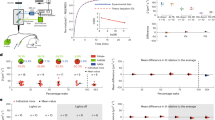Abstract
AKINESIA in Parkinson's disease is a complex phenomenon which resembles catalepsy and includes a reduction in motor activity as well as a certain degree of catatonia (maintenance of a fixed passively imposed position). Akinesia as a clinical sign may be connected with changes in the metabolism of dopamine (DA), a substance involved in the pathogenesis of Parkinson's disease1. Experimental investigations in animals strengthen the evidence for a relationship between catecholamines and control of motility. Fisher and Lopez Amalfara2 found that epinephrine (E) and norepinephrine (NE) caused a motor depression, while Ernst3 produced a striking akineto-rigid syndrome in cats with injections of two possible dopamine metabolites: 3,4-dimethoxy-phenylethylamine (DIMPEA) and 4-methoxyphenylethylamine (4-MEPEA), both structurally related to mescaline (3,4,5-trimethoxyphenylethylamine). These investigations gained further significance with the identification of DIMPEA in the urine of schizophrenic patients by Friedhoff and Van Winkle4 and others since5. This same compound was found by Barbeau et al. in high concentration in the urine of clinically akinetic parkinsonian patients6.
This is a preview of subscription content, access via your institution
Access options
Subscribe to this journal
Receive 51 print issues and online access
$199.00 per year
only $3.90 per issue
Buy this article
- Purchase on Springer Link
- Instant access to full article PDF
Prices may be subject to local taxes which are calculated during checkout
Similar content being viewed by others
References
Barbeau, A., Murphy, G. F., and Sourkes, T. L., Science, 133, 1706 (1961). Ehringer, H., and Hornykiewicz, O., Klin. Wochschr., 38, 1236 (1960).
Fisher, E., and Lopez Amalfara, M., Nature, 193, 590 (1962).
Ernst, A. M., Nature, 193, 178 (1962).
Friedhoff, A. J., and Van Winkle, E., Nature, 194, 867 (1962).
Kuehl, F. A., Hichens, M., Osmond, R. E., Meisinger, M. A. P., Gale, P. H., Cirillo, V. J., and Brink, N. G., Nature, 203, 154 (1964).
Barbeau, A., de Groot, J. A., Joly, J. G., Raymond Tremblay, D., and Donaldson, J., Rev. Can. Biol., 22, 469 (1963).
Friedhoff, A. J., and Van Winkle, E., J. Chromatogr., 11, 272 (1963).
Neff, N., Rossi, G. V., Chase, G. D., and Rabinowitz, J. L., J. Pharm. Exp. Therap., 144, 1 (1964).
Smythies, J. R., and Sykes, E. A., Fed. Proc., 24, 196 (1965).
Author information
Authors and Affiliations
Rights and permissions
About this article
Cite this article
BARBEAU, A., TÉTREAULT, L., OLIVA, L. et al. Pharmacology of Akinesia—Investigations on 3,4-Dimethoxyphenylethylamine. Nature 209, 719–721 (1966). https://doi.org/10.1038/209719a0
Issue Date:
DOI: https://doi.org/10.1038/209719a0
This article is cited by
-
Biochemical Research in Schizophrenia
Nature (1971)
-
Urinary Metabolites in Parkinson's Disease
Nature (1968)
-
Urinary Excretion of 3,4-Dimethoxyphenylethylamine in Parkinson's Disease
Nature (1967)
-
Effects of homoveratrylamine (3,4-Dimethoxyphenylethylamine) on the histamine responses and on the histaminolytic power of hog kidney diamine oxidase (DAO)
Psychopharmacologia (1967)
-
Effect of 3,4-dimethoxyphenylethylamine injections upon dopamine metabolism in rats and dogs
Experientia (1967)
Comments
By submitting a comment you agree to abide by our Terms and Community Guidelines. If you find something abusive or that does not comply with our terms or guidelines please flag it as inappropriate.



